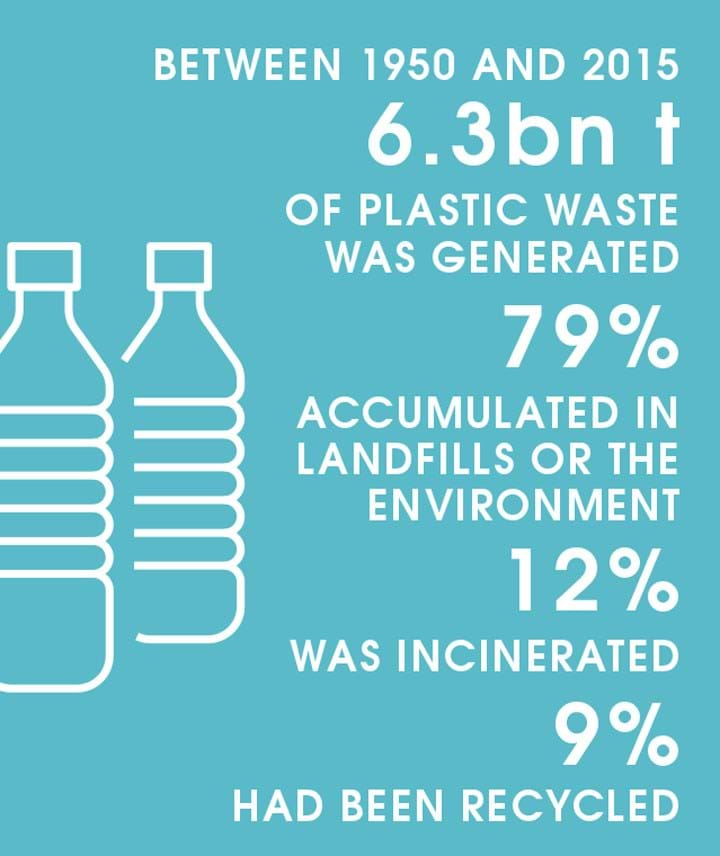Materials: Upcycling – Making Plastic Waste Valuable

Amanda Jasi speaks to researchers working to realise novel chemical upcycling methods
PLASTIC waste is one of the major challenges of our time. An often-referenced 2017 paper states that of the 6.3bn t of plastic waste generated between 1950 and 2015, 79% had accumulated in landfills or the natural environment. Of the remaining amount, 12% was incinerated and only around 9% had been recycled.
Shifting to a circular economy model that uses end-of-life plastics as a resource would help to eliminate waste. Taking the concept further, upcycling would incentivise the use of end-of-life plastics as a resource by offering the chance to produce value-added products.
The current prevailing method of plastics recycling – mechanical recycling – is currently limited by eventual material downcycling due to harsh remelting conditions used, ultimately forcing materials to be repurposed for lower-value applications. Though according to Jack Payne, while mechanical recycling doesn’t necessarily prohibit upcycling, chemical methods offer a greater opportunity to do so, enabling a diverse range of value-added products to be accessed. Payne is a PhD student at the University of Bath, UK, with research focusing on catalysis for renewable plastic production and recycling.
Currently, chemical recycling is in the early stages of development. But Matthew Jones, Professor of Chemistry at Bath, says that he expects it to advance further in the next five years, giving more options for how to handle plastic waste. He says that in the future, chemical and mechanical recycling could act as complimentary techniques, each offering a preferential route depending on the plastic type and waste mixtures involved.
The Chemical Engineer spoke to Payne, Jones, and other researchers investigating novel chemical recycling methods for managing commonly produced plastics, to understand the challenges associated with realising this promising recycling route.

One-pot upcycling
Polyvinyl chloride (PVC) is one of the most commonly-used plastics, widely used for furnishings, piping, and medical supplies. Unfortunately, PVC presents a challenge for mechanical recycling.
The mechanical recycling process involves sorting, grinding, washing, melting, and remoulding PVC into new plastic products. However, due to its low thermal stability PVC wastes can decompose during melting and remodelling. PVC’s high plasticiser content and environmental sensitivity further hinder the process.
Chemical recycling is a promising alternative that is under investigation. Researchers in China are developing a chemical upcycling method, which has the benefit of preventing the pollution associated with mechanical recycling, and incineration.
Xiao-Li Zhou, Postdoctoral Fellow at Nanjing Tech University, China, says: “The approach was designed following the one-pot strategy. By carefully designing the reaction sequence, the substances and conditions formed at the first step trigger the second stage reaction, and so does the next stage.”
He explained that for the process, PVC and Cl-fixative are added to a 5 mL stainless steel reactor. Potassium hydroxide (KOH) and zinc oxide are also added. Zhou says metal oxides and hydroxides are commonly used as inhibitors or sorbents to stabilise chlorine into corresponding metal chlorides to prevent formation of hydrochloric acid and Cl-containing oils. The reactor is then sealed and heated to 215–350°C.
Zhou continued: “PVC reacts with Cl-fixative to produce chlorides and dechlorinated polyenes. The produced polyenes pyrolyse into residual carbon and volatile hydrocarbons under higher temperatures: 380–500°C. The volatiles are trapped in the sealed reactor and will further carbonise, which can increase the yield of carbon materials. After, or during, the carbonisation, zinc chloride and KOH as activation agents can modify the structure and improve the properties of carbon materials for various applications.”
Zhou says that depending on their properties and performance, carbon materials can be used in various fields. “Carbon spheres at a micrometre scale with a high graphitisation degree can be used in battery electrodes, painting, rubber, and polymer composites. Porous carbon materials are promising materials as pollutant adsorbents, catalyst carriers, and supercapacitor electrodes,” he says.
The process also generates high purity methane (>98%), which can be used as a substitute for natural gas, acting as an auxiliary fuel in plants, or as an industrial feedstock. Chloride products can be washed out from the solid product and used as an industrial feedstock.
Zhou highlights that the process is still experimental and needs further exploration. At the moment, the researchers are screening efficient Cl-fixatives and corresponding mechanical support. Research is also required into the behaviour of the PVC during the one-pot reaction, and the influences of additives and impurities.
Despite the early stage of the work, the researchers have considered how this technology will be achieved at scale. According to Zhou, to overcome the limited production efficiency of a batch reactor, a continuous process is required to increase capacity and improve efficiency. A continuous process would need to provide sufficient reaction pressure and residual time for dechlorination, carbonisation, and modification at the same time.
Work on this process was published in April, at which time Zhou was completing his PhD at Tongji University, China. Zhou continues to develop the technology in collaboration with Hua Zhang, Professor at the College of Environmental Science and Engineering at Tongji.
Recent Editions
Catch up on the latest news, views and jobs from The Chemical Engineer. Below are the four latest issues. View a wider selection of the archive from within the Magazine section of this site.




